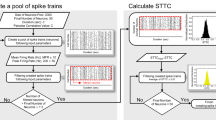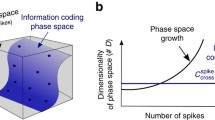Abstract
A spike-phase neural code has been proposed as a mechanism to encode stimuli based on the precise timing of spikes relative to the phase of membrane potential oscillations. This form of coding has been reported in both in vivo and in vitro experiments across several regions of the brain, yet there are concerns that such precise timing may be compromised by an effect referred to as variance accumulation, wherein spike timing variance increases over the phase of an oscillation. Here, we provide a straightforward explanation of this effect based on the theoretical spike time variance. The proposed theory is consistent with recordings of mitral neurons. It shows that spike time variance can increase in a nonlinear fashion with spike number, in a way that is dependent upon the frequency and amplitude of the oscillation. Further, non-monotonic accumulation of variance can arise from different combinations of oscillation parameters. Nonlinear accumulation sometimes leads to lower variance than that of a mean rate-matched homogeneous Poisson process, particularly for spikes that occur in later phases of oscillation. However, such an advantage is limited to a narrow range of oscillation amplitudes and frequencies. These results suggest fundamental constraints on spike-phase coding, and reveal how certain spikes in a sequence may exhibit increased firing time precision relative to their neighbors.






Similar content being viewed by others
References
Brody CD, Hopfield J (2003) Simple networks for spike-timing-based computation, with application to olfactory processing. Neuron 37(5):843–852
Buzsaki G, Draguhn A (2004) Neuronal oscillations in cortical networks. Science 304(5679):1926–1929
Buzsaki G, Wang XJ (2012) Mechanisms of gamma oscillations. Annu Rev Neurosci 35:203–225
Cang J, Isaacson JS (2003) In vivo whole-cell recording of odor-evoked synaptic transmission in the rat olfactory bulb. J Neurosci 23(10):4108–4116
Cohen J, Cohen P, West SG, Aiken LS (2013) Applied multiple regression/correlation analysis for the behavioral sciences. Routledge, Abingdon
Cury KM, Uchida N (2010) Robust odor coding via inhalation-coupled transient activity in the mammalian olfactory bulb. Neuron 68(3):570–585
Dumont G, Northoff G, Longtin A (2016) A stochastic model of input effectiveness during irregular gamma rhythms. J Comput Neurosci 40(1):85–101
Engel AK, Fries P, Singer W (2001) Dynamic predictions: oscillations and synchrony in top-down processing. Nat Rev Neurosci 2(10):704
Friedrich RW, Stopfer M (2001) Recent dynamics in olfactory population coding. Curr Opin Neurobiol 11(4):468–474
Fries P, Nikoli D, Singer W (2007) The gamma cycle. Trends Neurosci 30(7):309–316
Hafting T, Fyhn M, Bonnevie T, Moser MB, Moser EI (2008) Hippocampus-independent phase precession in entorhinal grid cells. Nature 453(7199):1248
Harris KD (2005) Neural signatures of cell assembly organization. Nat Rev Neurosci 6(5):399
Harris KD, Henze DA, Hirase H, Leinekugel X (2002) Spike train dynamics predicts theta-related phase precession in hippocampal pyramidal cells. Nature 417(6890):738
Jensen O, Colgin LL (2007) Cross-frequency coupling between neuronal oscillations. Trends Cogn Sci 11(7):267–269
Kayser C, Montemurro MA, Logothetis NK, Panzeri S (2009) Spike-phase coding boosts and stabilizes information carried by spatial and temporal spike patterns. Neuron 61(4):597–608
Latham PE, Lengyel M (2008) Phase coding: spikes get a boost from local fields. Curr Biol 18(8):R349–R351
Laurent G (2002) Olfactory network dynamics and the coding of multidimensional signals. Nat Rev Neurosci 3(11):884
Laurent G, Davidowitz H (1994) Encoding of olfactory information with oscillating neural assemblies. Science 265(5180):1872–1875
Lisman J (2005) The theta/gamma discrete phase code occuring during the hippocampal phase precession may be a more general brain coding scheme. Hippocampus 15(7):913–922
Margrie TW, Schaefer AT (2003) Theta oscillation coupled spike latencies yield computational vigour in a mammalian sensory system. J Physiol 546(2):363–374
Masuda N, Doiron B (2007) Gamma oscillations of spiking neural populations enhance signal discrimination. PLoS Comput Biol 3(11):e236
Mehta M, Lee A, Wilson M (2002) Role of experience and oscillations in transforming a rate code into a temporal code. Nature 417(6890):741
Miura K, Mainen ZF, Uchida N (2012) Odor representations in olfactory cortex: distributed rate coding and decorrelated population activity. Neuron 74(6):1087–1098
Montemurro MA, Rasch MJ, Murayama Y, Logothetis NK, Panzeri S (2008) Phase-of-firing coding of natural visual stimuli in primary visual cortex. Curr Biol 18(5):375–380
O’Keefe J, Burgess N (2005) Dual phase and rate coding in hippocampal place cells: theoretical significance and relationship to entorhinal grid cells. Hippocampus 15(7):853–866
Panzeri S, Petersen RS, Schultz SR, Lebedev M, Diamond ME (2001) The role of spike timing in the coding of stimulus location in rat somatosensory cortex. Neuron 29(3):769–777
Ross S (2007) Introduction to probability models. Academic Press, Boston
Schaefer AT, Angelo K, Spors H, Margrie TW (2006) Neuronal oscillations enhance stimulus discrimination by ensuring action potential precision. PLoS Biol 4(6):e163
Shusterman R, Smear MC, Koulakov AA, Rinberg D (2011) Precise olfactory responses tile the sniff cycle. Nat Neurosci 14(8):1039–1044
Singer W (1999) Neuronal synchrony: a versatile code for the definition of relations? Neuron 24(1):49–65
Thorpe S, Fize D, Marlot C (1996) Speed of processing in the human visual system. Nature 381:520
Tiesinga P, Fellous JM, Sejnowski TJ (2008) Regulation of spike timing in visual cortical circuits. Nat Rev Neurosci 9(2):97
Turesson HK, Logothetis NK, Hoffman KL (2012) Category-selective phase coding in the superior temporal sulcus. Proc Natl Acad Sci USA 109(47):19,438–19,443
Wang HP, Spencer D, Fellous JM, Sejnowski TJ (2010) Synchrony of thalamocortical inputs maximizes cortical reliability. Science 328(5974):106–109
Wang XJ (2010) Neurophysiological and computational principles of cortical rhythms in cognition. Physiol Rev 90(3):1195–1268
Acknowledgements
This work was supported by grants to J.P.T. from the Natural Sciences and Engineering Council of Canada (NSERC Grant No. 210977 and No. 210989), the Canadian Institutes of Health Research (CIHR Grant No. 6105509), and the University of Ottawa Brain and Mind Institute (uOBMI), as well as a graduate scholarship to E.S.K. from NSERC. AL also acknowledges support from NSERC. The authors are thankful to Alfonso Renart, Andreas Schaefer, and Maurice Chacron for useful discussions.
Author information
Authors and Affiliations
Corresponding author
Ethics declarations
Conflict of interest
The authors declare no competing financial interests.
Additional information
Communicated by J. Leo van Hemmen.
Electronic supplementary material
Below is the link to the electronic supplementary material.
Rights and permissions
About this article
Cite this article
Kuebler, E.S., Calderini, M., Longtin, A. et al. Non-monotonic accumulation of spike time variance during membrane potential oscillations. Biol Cybern 112, 539–545 (2018). https://doi.org/10.1007/s00422-018-0782-x
Received:
Accepted:
Published:
Issue Date:
DOI: https://doi.org/10.1007/s00422-018-0782-x




